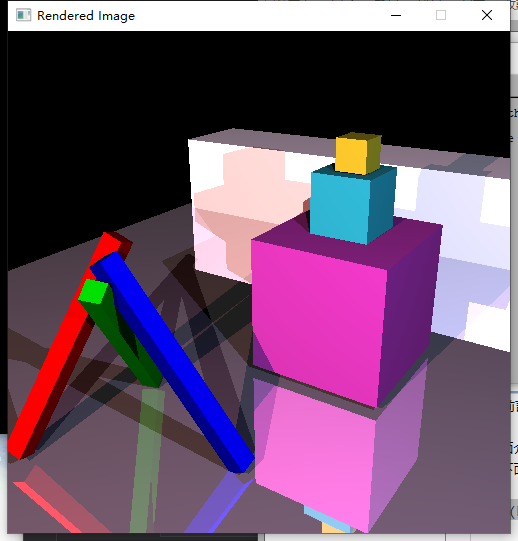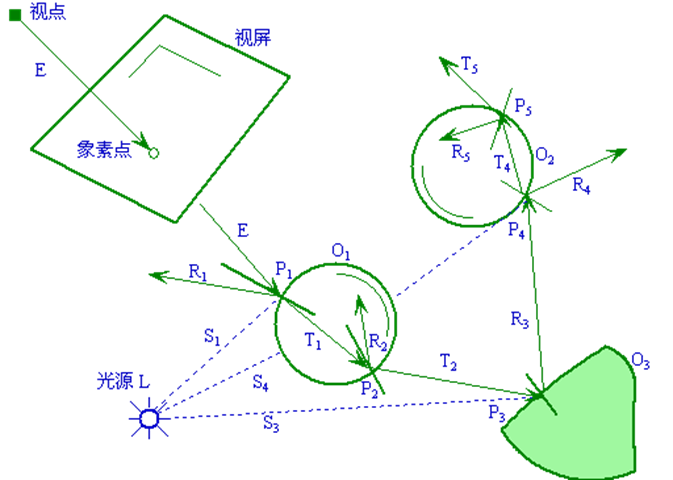從零開始openGL——五、光線追蹤
前言
前面介紹了基本圖形、模型、曲線的繪製,但是,在好像還沒有感受到那種3D遊戲裡一些能驚豔到自己的效果,即真實感還不是很足。這篇文章中介紹的光線追蹤,是實現真實感必不可少的。拿下面的兩張圖片來對比


對比一下是不是被下面這張圖片的效果驚豔到了?可以很明顯感覺到,下面的這個圖片效果要好的多。這篇部落格將介紹如何實現這樣的效果。
光線求交
這裡暫時只介紹光線與球面和三角面片的求交
光線與球面相交
射線的方程:
\[
R(t) = A+tD
\]
球面的隱式方程:
\[
(X-C)^2=r^2
\]
聯立兩式:
\[
(A+tD-C)^2=r^2
\]
然後通過判別式:\[\Delta=4[(A-C) \cdot D]^2 - 4(A-C)^2+r^2\]來判斷是否相交。
交點法向量:
\[
N=\frac{P-C}{||P-C||}
\]
bool Sphere::intersectLocal( const ray& r, isect& i ) const { // YOUR CODE HERE: // 光線與球面相交 // Add sphere intersection code here. Vec3d A = r.getPosition(); Vec3d D = r.getDirection(); Vec3d C= Vec3<double>(); double _r = 1.0; double a = D.length2(); double b = 2 * (A - C) * D; double c = (A - C).length2() - _r; double delta = b * b - 4 * a * c; // it currently ignores all spheres and just return false. if (delta >= 0) { double t1 = (-b + sqrt(delta)) / (2 * a); double t2 = (-b - sqrt(delta)) / (2 * a); if (t1 <= RAY_EPSILON) return false; else { double t; if (t2 <= RAY_EPSILON) { t = t1; i.outsideTheObject = false; } else { t = t2; i.outsideTheObject = true; } // 焦點設定 i.obj = this; i.setT(t); Vec3d P = r.at(t); Vec3d Normal = P; if (D*Normal > 0) Normal = -Normal; Normal.normalize(); i.setN(Normal); return true; } } return false; }
光線與三角面片相交
射線的方程:
\[
R(t) = A+tD
\]
三角面片點法式方程:
\[
N(p-p_1)=0
\]
聯立兩式得:
\[
t=\frac{N\cdot p_1 - N \cdot A}{n\cdot D}
\]
求出t後,便得到交點座標,然後可通過同向法來判別交點是否在平面內。

// Calculates and returns the normal of the triangle too. bool TrimeshFace::intersectLocal(const ray& r, isect& i) const { // YOUR CODE HERE: // Add triangle intersection code here. // it currently ignores all triangles and just return false. // // Note that you are only intersecting a single triangle, and the vertices // of the triangle are supplied to you by the trimesh class. // // You should retrieve the vertices using code like this: // // const Vec3d& a = parent->vertices[ids[0]]; // const Vec3d& b = parent->vertices[ids[1]]; // const Vec3d& c = parent->vertices[ids[2]]; const Vec3d& a = parent->vertices[ids[0]]; const Vec3d& b = parent->vertices[ids[1]]; const Vec3d& c = parent->vertices[ids[2]]; Vec3d edge1 = b - a; Vec3d edge2 = c - a; // 計算平面法向量 Vec3d nor = edge1 ^ edge2; nor.normalize(); // 判斷是否與平面平行 float x = nor * r.getDirection(); if (x == 0) return false; // Ax + By + Cz = d float d = nor * a; float t = (d - nor * r.getPosition()) / x; if (t <= RAY_EPSILON) return false; Vec3d intersection_point = r.at(t); Vec3d edge3 = intersection_point - a; // 同向法判斷是否在平面內 if (((b - a) ^ (intersection_point - a)) * nor <= 0) return false; else if (((c - b) ^ (intersection_point - b)) * nor <= 0) return false; else if (((a - c) ^ (intersection_point - c)) * nor <= 0) return false; else { //交點設定 i.obj = this; i.setT(t); i.setN(nor); return true; } }
當然,這裡還可以使用重心座標法來實現
光線衰減
在現實場景中,光線也是會衰減的,比如看同一場景,距離遠近不同看到的清晰度也就不同,這是距離衰減。還有陰影衰減,當有物體遮擋住部分光的時候,會形成一定的陰影,這就是陰影衰減產生的效果。
距離衰減
點光源:
\[
A_{j}^{d i s t}=\min \left\{1, \frac{1}{a_{j}+b_{j} r_{j}+c_{j} r_{j}^{2}}\right\}
\]
double PointLight::distanceAttenuation( const Vec3d& P ) const
{
// You'll need to modify this method to attenuate the intensity
// of the light based on the distance between the source and the
// point P. For now, we assume no attenuation and just return 1.0
Vec3d d = P - position;
double r = d.length(); //距離
return min(1.0, 1.0 / (constantTerm + linearTerm * r + quadraticTerm * r*r));
// return 1.0;
}平行光源:
double DirectionalLight::distanceAttenuation( const Vec3d& P ) const
{
// distance to light is infinite, so f(di) goes to 0. Return 1.
return 1.0;
}陰影衰減
點光源:
首先判斷光線是否被遮擋,然後再判斷是否超出光強所能打到的距離
Vec3d PointLight::shadowAttenuation(const Vec3d& P) const
{
// YOUR CODE HERE:
// You should implement shadow-handling code here.
Vec3d d = getDirection(P);
isect i;
ray shadowRay(P, d);
if (this->getScene()->intersect(shadowRay, i)) {
double tLight = (P - position).length();
if (i.t < tLight)
return Vec3d(0, 0, 0);
else
return Vec3d(1, 1, 1);
}
return Vec3d(1,1,1);
}
平行光:
只需判斷是否被遮擋即可
Vec3d DirectionalLight::shadowAttenuation( const Vec3d& P ) const
{
// YOUR CODE HERE:
Vec3d d = getDirection(P);
isect i;
ray shadowRay(P, d);
if (this->getScene()->intersect(shadowRay, i)) {
return Vec3d(0, 0, 0);
}
// You should implement shadow-handling code here.
return Vec3d(1,1,1);
}光線追蹤
先來份虛擬碼

光線跟蹤中的四種射線:
視線:由視點與象素(x,y)發出的射線
陰影測試線:物體表面上點與光源的連線
反射光線
折射光線
光線追蹤的過程

phong光照模型
由物體表面上一點P反射到視點的光強I為環境光的反射光強\(I_e\)、理想漫反射光強\(I_d\)、和鏡面反射光\(I_s\)的總和,即
\[
I=I_ak_a + I_lk_d(L \cdot N)+k_s\sum_{i=1}^{m}[I_{pi}(R \cdot V)^n]
\]
在washington CSE 457的課件中給出的公式為
\[
l_{\text {direct }}=k_{e}+k_{e} I_{L s}+\sum_{f} A_{j}^{\text {shadow}} A_{j}^{\text {dist}} I_{L j} B_{j}\left[k_{d}\left(\mathbf{N} \cdot \mathbf{L}_{j}\right)+k_{s}\left(\mathbf{N} \cdot \mathbf{H}_{j}\right)^{n_{s}}\right]
\]
其中\(k_d\)項表示漫反射,採用Lamber模型,\(k_s\)項表示鏡面反射
\[
I_{d}=I_{p} K_{d} *(L \cdot N)
\]
\[ I_{s}=k_{s} I_{p}(R \cdot V)^{n} \]
即可寫出下列程式碼
// Apply the Phong model to this point on the surface of the object, returning
// the color of that point.
Vec3d Material::shade( Scene *scene, const ray& r, const isect& i ) const
{
// YOUR CODE HERE
// For now, this method just returns the diffuse color of the object.
// This gives a single matte color for every distinct surface in the
// scene, and that's it. Simple, but enough to get you started.
// (It's also inconsistent with the Phong model...)
// Your mission is to fill in this method with the rest of the phong
// shading model, including the contributions of all the light sources.
// You will need to call both distanceAttenuation() and shadowAttenuation()
// somewhere in your code in order to compute shadows and light falloff.
if( debugMode )
std::cout << "Debugging the Phong code (or lack thereof...)" << std::endl;
Vec3d pos = r.at(i.t);
Vec3d N = i.N;
N.normalize();
Vec3d Ip, L, H, Atten;
Vec3d shadow = ke(i) + prod(scene->ambient(), ka(i));
for (vector<Light*>::const_iterator litr = scene->beginLights();
litr != scene->endLights(); ++litr) {
Light* pLight = *litr;
Ip = pLight->getColor(pos);
L = pLight->getDirection(pos);
H = -r.getDirection() + L; H.normalize();
Atten = pLight->distanceAttenuation(pos)*pLight->shadowAttenuation(pos);
shadow += prod(Atten, prod(Ip, kd(i)*(L*N) + ks(i)*pow(H*N, 256)));
}
return shadow;
}反射方向
這裡的反射指的是鏡面反射
計算公式:
\[
R=2(V\cdot N)N-V
\]
為什麼是這樣呢?首先來看\(V\cdot N\),這裡N是交點處的法向量,並且是單位向量,那個即視線在法向量上的投影,再乘法向量的兩倍,得到的是平行四邊形的對角線,減去V便是反射後的光線的方向。

折射方向
跟反射方向一樣都是公式推導
\[
\begin{array}{l}{\eta=\frac{\eta_{i}}{\eta_{t}}} \\ \eta_{i} \sin \theta_{i}=\eta_{t} \sin \theta_{t} \\ {\cos \theta_{i}=\mathbf{N} \cdot \mathbf{V}} \\ {\cos \theta_{t}=\sqrt{1-\eta^{2}\left(1-\cos ^{2} \theta_{i}\right)}} \\ {\mathbf{T}=\left(\eta \cos \theta_{i}-\cos \theta_{t}\right) \mathbf{N}-\eta \mathbf{V}}\end{array}
\]

終止條件
經過上述的介紹,很容易可以想到,什麼時候終止光線追蹤
該光線未碰到任何物體
該光線碰到了背景
光線在經過許多次反射和折射以後,就會產生衰減,光線對於視點的光強貢獻很小(小於某個設定值)。
光線反射或折射次數即跟蹤深度大於一定值
因此,光線追蹤的程式碼實現如下
// Do recursive ray tracing! You'll want to insert a lot of code here
// (or places called from here) to handle reflection, refraction, etc etc.
Vec3d RayTracer::traceRay( const ray& r,
const Vec3d& thresh, int depth )
{
isect i;
if( scene->intersect( r, i ) && depth >= 0) {
const Material& m = i.getMaterial();
//計算光源直射
Vec3d I = m.shade(scene, r, i);
//計算反射遞迴
Vec3d Q = r.at(i.t);
Vec3d R = r.getDirection() - 2 * (r.getDirection()*i.N)*i.N;
R.normalize();
I += prod(m.kr(i), traceRay(ray(Q, R), thresh, depth - 1));
//計算折射遞迴
double cosThetaI = -i.N*r.getDirection();
double eta = (i.outsideTheObject) ? 1.0003 / m.index(i) : m.index(i) / 1.0003;
if (eta*eta*(1 - cosThetaI * cosThetaI) < 1) {
double cosThetaT = sqrt(1 - eta * eta*(1 - cosThetaI * cosThetaI));
Vec3d T = (eta*cosThetaI - cosThetaT)*i.N - eta * r.getDirection();
T.normalize();
I += prod(m.kt(i), traceRay(ray(Q, -T), thresh, depth - 1));
}
return I;
// An intersection occured! We've got work to do. For now,
// this code gets the material for the surface that was intersected,
// and asks that material to provide a color for the ray.
// This is a great place to insert code for recursive ray tracing.
// Instead of just returning the result of shade(), add some
// more steps: add in the contributions from reflected and refracted
// rays.
//const Material& m = i.getMaterial();
//return m.shade(scene, r, i);
} else {
// No intersection. This ray travels to infinity, so we color
// it according to the background color, which in this (simple) case
// is just black.
return Vec3d( 0.0, 0.0, 0.0 );
}
}小節
到這裡,光線追蹤也就差不多介紹完了,這一系列部落格也算是收尾了。那天在課上聽其他同學展示的的時候,說是我的世界有部分的開源原始碼,裡面有一個可以實現光追的介面,有興趣的小夥伴可以去康康,似乎那個僅僅實現光追還無法達到很好的效果,還要加上路線追蹤,emmmmm。。。。期末考完有空了我再去康康,明早圖形學考試祝我好運
